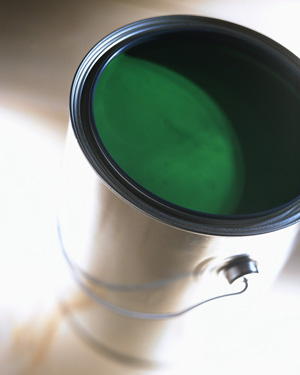It’s spring again and time for home improvement. This could mean anything from new landscaping to refurnishing the living room, and it could even mean giving the inside of the home a burst of color with a fresh coat of paint. However, choosing the right paint can make an impact on the environment, so being careful to select the right products is essential to living a healthy, environmentally-friendly lifestyle.
 Many paints on the market contain Volatile Organic Compounds. Such paints, in combination with other architectural coatings, produce around 9 percent of VOC emissions from all consumer and commercial products, according to the U.S Environmental Protection Agency. The EPA describes VOCs as “emitted as gases from certain solids or liquids” that include “a variety of chemicals, some of which may have short- and long-term adverse health effects.” Examples of VOC products are paints, lacquers, paint strippers, cleaning supplies, building materials and furnishings, pesticides, office equipment, permanent markers and more.
Many paints on the market contain Volatile Organic Compounds. Such paints, in combination with other architectural coatings, produce around 9 percent of VOC emissions from all consumer and commercial products, according to the U.S Environmental Protection Agency. The EPA describes VOCs as “emitted as gases from certain solids or liquids” that include “a variety of chemicals, some of which may have short- and long-term adverse health effects.” Examples of VOC products are paints, lacquers, paint strippers, cleaning supplies, building materials and furnishings, pesticides, office equipment, permanent markers and more.
An important thing worth noting when it comes to how VOCs are unhealthy is that the EPA has found they can cause a number of health effects in humans. The effects include eye, nose and throat irritation, headaches, nausea, and damage to the liver, kidney and central nervous system. The organics used in these products have even been shown to cause cancer in animals, and some are also suspected to cause cancer in humans as well. According to the EPA, “Key signs or symptoms associated with exposure to VOCs include conjunctival irritation, nose and throat discomfort, headache, allergic skin reaction, dyspnea, declines in serum cholinesterase levels, nausea, emesis, epistaxis, fatigue, dizziness.”
What the EPA has also found is that indoor concentration levels of VOCs can be up to ten times higher than outdoor concentration levels. However, just because some paints contain high levels of VOCs doesn’t necessarily mean refraining from painting the house this spring.
There are paints on the market that specifically have low levels of VOCs in order to help protect the environment. Examples of such products are those with Green Seal certification. According to GreenSeal.org, the Green Seal Environmental Standard for Paints and Coatings “includes product performance requirements and environmental and health requirements such as reduced use of hazardous substances and requires low volatile organic compound (VOC) content.”
For a list of Green Seal certified paints, visit http://www.greenseal.org/findaproduct/paints_coatings.cfm.
For more information on Green Products and Services for the home as well as Helpful Hints for going green, visit our Green Homes section.
Jennifer Griffin, Contributing Writer and Public Relations, GreeningDetroit.com
Jennifer is pursuing a degree in Journalism and English from Wayne State University, and she is also a Contributing Writer for The South End.


